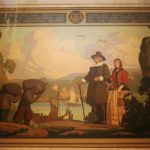
Courtesy Andrew Hanna, BowShot
The Swedes are coming! The Swedes are coming! In fact by the time you read this they already will have been here. On June 3, I received an email from Jim Williams, a volunteer at the Riverfront Marina in Newburgh. He had worked for nearly a year to have the Kalmar Nyckel (above left) sail to Newburgh from Delaware where it is based. This would follow the arrival of the Nina and Pinta which recently left Newburgh in May after a 4 day visit with 3-4,000 people going on board the ships.
Jim asked my help in spreading the word so I forwarded the notice to John Warren, editor, New York History Blog. The notice for the event July 24-26, ran on July 14.
According to the website of the Kalmar Nyckel Foundation:
The original Kalmar Nyckel served as Governor Peter Minuit’s flagship for the 1638 expedition that founded the colony of New Sweden, establishing the first permanent European settlement in the Delaware Valley, Fort Christina, in present-day Wilmington, Delaware. She would make a total of four roundtrip crossings of the Atlantic, more than any other documented ship of the American colonial era.
The original ship — a new type of gun-armed merchant vessel called a Dutch Pinnace — was built by the Dutch in Amsterdam in about the year 1625. She was purchased in 1629 by a Swedish consortium to serve as an auxiliary warship for the Swedish navy, which she did until her decommissioning in 1651 — except for the years from 1637 to 1644 when she sailed the Atlantic for the New Sweden Company. An exceptional ship with a long and remarkable career, she was sold to a private merchant after being decommissioned from the navy. No completely definitive records have been uncovered as of yet, but Kalmar Nyckel was probably resold to the Dutch navy as an escort vessel and sunk in the North Sea while fighting for the Dutch in a war against the English in 1652.
As one can see from this description, the histories of the Dutch and the Swedish were closely intertwined at the dawn of the colonial era in what became the United States.
The Bronx Is Up and Sweden Is Home

A mural in the rotunda of the Bronx County Courthouse
depicts Jonas Bronck arriving in Westchester County.
This led me to some news clippings which had I saved from last August, 2014. The small town of Savsjo in Sweden, population roughly 5000, decided to celebrate the 375th anniversary of one of their own, Jonas Bronck, settling in what became the Bronx in 1639. He lived around East 132nd Street and Lincoln Avenue near a river and a parkway that would later bear his name. The celebration included the unveiling of a monument to him in the presence of his “descendants” including a tenth-generation individual named Jonas Bronck. Other participants were officials from the Sweden and the Bronx including Lenny Caro, president of the Bronx Chamber of Commerce who delivered an official proclamation from the Bronx before leading the people in an official Bronx cheer.
The catalyst for this effort was Brian Andersson, former commissioner of the New York City Department of Records. He is a Bronxite of Swedish descent seeking to foster ties between schools and businesses in Savsjo and the Bronx. His true motive may have been to expand the fanbase of the New York Yankees located in the South Bronx and yes, there already were Swedes wearing Yankee ball caps.
Bronx Borough historian Lloyd Ultan, the equivalent of a county historian outside New York City, helped document the Swedish origin of Bronk who married a Dutch woman before sailing to New Amsterdam. Ultan commented on the potential tourist benefit for Savsjo. Imagine if Bronxites today went on a pilgrimage to their roots as a borough to the very village of their namesake.
Actually the Bronk descendants may not be from Jonas Bronk. A post I wrote on the state of history in the Bronx in 2014, led David Dorpfeld, Greene County Historian, to send me information on the Bronks. He is based at the Bronck House in Coxsackie (spellings have varied over the years). He subscribes to the view that Pieter who founded the Coxsackie house and Jonas were first cousins. Jonas had no children so all descendants are from Pieter.
Swedes than are part of the diversity of the Bronx, New York City, New York State, and America. However, when it comes to diversity, Swedes probably aren’t the first people to come to mind. The intertwining of the Dutch and the Swedes during the early colonial days illustrates that throughout the colonial era in New York, white people were diverse. The idea that the French, Dutch, Palatines, Swedes, Irish and English were all one people was as absurd a concept to them as it would have been to the Lenape, Mohawk, and Onedia. These peoples often were at war with each other both in Europe and around the world. They all knew who they were and could not conceive of themselves as a single people.
Consider the words of Ben Franklin writing in 1751:
That the Number of purely white People in the World is proportionably very small. All Africa is black or tawny. Asia chiefly tawny. America (exclusive of the new Comers) wholly so. And in Europe, the Spaniards, Italians, French, Russians and Swedes, are generally of what we call a swarthy Complexion; as are the Germans also, the Saxons only excepted, who with the English, make the principal Body of White People on the Face of the Earth.
Who knew the Swedes were swarthy along with the Germans? Not only were white people diverse then, they weren’t even all white. Indeed the story of how the definition of white people expanded over time to include people who previously were excluded is part of the story of America.
As it turns out, Franklin’s analysis comports with classification systems used today. In an episode of the TV show Two Broke Girls, one white actress declares Spanish not to be a white language. Perhaps in the new geography, Spain is located in Latin America. Actually the French, Dutch, Germans, Swedes, Irish and English/Cornish still aren’t white if they arrive in America from Latin America; then they are Hispanic because they speak Spanish and didn’t come directly from Europe. However Danny and Marlo Thomas are Lebanese and have been considered white but Salma Hayek who is part Lebanese and Spanish from Mexico isn’t. Perhaps Danny and Marlo aren’t white either anymore. So based on the racial classification systems of both Franklin and the politically correct, Jonas Bronk would feel right at home in the Bronx today along with all his fellow non-white swarthy people of color.






your 2015 e-blast Sweden and Diversity in New York: All Caucasians Are Not White, I thought you might be interested in a painting of one of the “swarthy” Dutch (see attachment. please look now before you hear the rest. It a bit surprising).
It’s the painting of Philippa of Hainault and Holland. King Edward II was seeking a young girl who would be suitable for marriage to his heir (who would become King Edward III). Edward II sent the Bishop of Essex to meet with Count William I and check-out his 5 daughters. He was to choose one to to be affianced to the king’s 12-year-old son.The Bishop chose 8-year-old Philippa, and snt the king a description of her: “Her nose is fairly smooth and even, save that it is somewhat broad at the tip and flattened, yet it is no snub-nose. Her nostrils are also broad, her mouth fairly wide. Her lips somewhat full, and especially the lower lip… Moreover, she is of brown skin all over [Editor’s emphasis], and much like her father…”
If you looked at the picture already, you may have noticed that she is white of face.Her left-gloved hand does not match the right hand. The right hand appears to be bare. You can almost see fingertips.The color of the glove matches the epauletts on her shoulders. The bare hand matches the color of her face. The glove and epaulet were obviously painted at the same time, the hand and face at a later date. We have concluded that the original (which hangs at the Abbey Museum in London) was okay at first but when racism raised its ugly head, a painter was told to paint her face white and put a glove on her hand. The painter didn”t understand the objective, because if you look again, you’ll see that he painted her face white, painted a glove on her hand, but didn’t paint her (brown all over) arm.
Joysetta Pearse, Director
African American Museum of Nassau County